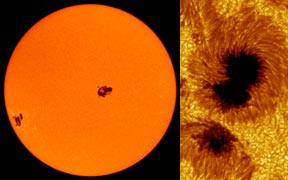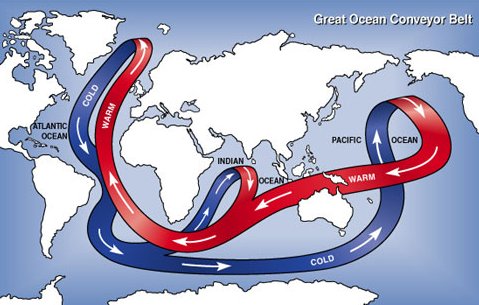The sun goes through cycles lasting approximately 11 years that include phases with increased magnetic activity, more sunspots, and more solar flares, and phases with less activity.
Click on image for full size
Image Courtesy of NOAA
Lower Solar Activity Linked to Changes in Sun's Conveyor Belt
The sun goes through cycles that last approximately 11 years. These solar cycle include phases with more magnetic activity, sunspots, and solar flares. They also include phases with less activity.
The level of activity on the sun can affect navigation and communications systems on Earth.
A team of scientists have studied the solar cycle that ended in 2008, which is known as solar cycle 23. This solar cycle was longer than normal, and the scientists think that one reason could be a stretching of the sun's conveyor belt. This is a current of plasma that circulates between the sun's equator and its poles.
Just as Earth's global ocean circulation transports water and heat around the planet, the sun has a conveyor belt in which plasma flows along the surface toward the poles, sinks, and returns toward the equator, transporting magnetic flux along the way.
The study was conducted by Mausumi Dikpati, Peter Gilman, and Giuliana de Toma, all scientists in the High Altitude Observatory at the National Center for Atmospheric Research (NCAR) in Boulder, Colorado, and by Roger Ulrich at the University of California, Los Angeles.
They used simulations to model how the solar plasma conveyor belt affects the solar cycle. They found that the longer conveyor belt and slower return flow could have caused the longer duration of cycle 23.
The results of this study should help scientists better understand the factors controlling the timing of solar cycles and could lead to better predictions. It can also allow us to be prepared for space weather.
You might also be interested in:

The Sun has a very large and very complex magnetic field. The magnetic field at an average place on the Sun is around 1 Gauss, about twice as strong as the average field on the surface of Earth (around
...more
Sunspots are dark, planet-sized regions that appear on the "surface" of the Sun. Sunspots are "dark" because they are colder than the areas around them. A large sunspot might have a temperature of about
...more
Seawater moves through the Atlantic as part of the Global Ocean Conveyor, the regular pattern by which seawater travels the world’s oceans. The water in the Global Ocean Conveyor circulates because of
...more
Scientists have learned that Mount Hood, Oregon's tallest mountain, has erupted in the past due to the mixing of two different types of magma. "The data will help give us a better road map to what a future
...more
The Earth's mantle is a rocky, solid shell that is between the Earth's crust and the outer core, and makes up about 84 percent of the Earth's volume. The mantle is made up of many distinct portions or
...more
Some geologic faults that appear strong and stable, slip and slide like weak faults, causing earthquakes. Scientists have been looking at one of these faults in a new way to figure out why. In theory,
...more
The sun goes through cycles that last approximately 11 years. These solar cycle include phases with more magnetic activity, sunspots, and solar flares. They also include phases with less activity. The
...more














